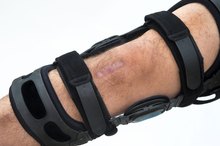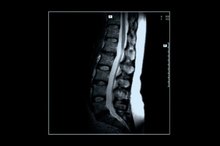Complications With Lateral Release Knee Surgery
The patella, or knee cap, is designed to track in a special groove of the knee called the femoral notch, or trochlea. As the knee bends and straightens, the patella glides through this groove, creating a leverage element that assists with these movements. When a patella becomes unstable, it can cause problems with tracking through the regular motion of the knee, resulting in partial, or even total, dislocation. There are surgical procedures designed to correct the cause of the tracking and instability problem, such as the lateral release, but they do not come without potential for complications.
If you are experiencing serious medical symptoms, seek emergency treatment immediately.
Bleeding into the Knee Joint
When a lateral release procedure is performed, there is a risk of injury to blood vessels, which can result in the accumulation of blood in the knee joint. The presence of blood in the knee joint is known as a hemarthrosis. If the amount of blood accumulated is sufficient enough, it can result in pain and risk of infection.
Increased Patellar Instability
Complications After Partial Knee Replacement
Learn More
When a lateral release procedure is performed, the part of the capsular tissue known as the lateral retinaculum is incised to cause:
- a release of confining fibers
- allow the kneecap to drift more toward the medial
- or inner
- portion of the knee
- which improves tracking
While the knee is in the healing phase, the knee cap is unstable, by design, and care must be taken to avoid accidental dislocation. While lateral release alone can typically solve patellar instability issues, if it becomes more unstable afterward, more surgery may be needed to improve stability.
Prolonged or Chronic Knee Pain
If there has been any joint surface cartilage injury or damage to either the knee cap or the femur from repeated partial dislocation, or complete dislocation, the pain caused by the cartilage damage can persist. When the patella is re-aligned, abnormal forces may be applied to the roughened surfaces of the patella and femur, or thigh bone, furthering pain with bending and straightening.
Persistent Knee Stiffness
Knee Cap Pain & Swelling
Learn More
In some cases, prolonged stiffness of the knee can become a complication of lateral release knee surgery 4. The stiffness can be caused by scar formation, difficulty with movement because of pain and simply due to the realignment itself. Some cases of stiffness can last months or even become permanent.
Medial Subluxation
In a study of 60 knees in 54 patients, a complication of lateral release knee surgery became evident--medial patellar subluxation, or partial dislocation The research reported this finding as new and previously unsupported, but the conditions did occur in 30 of the 60 knees 4. This painful condition involves the partial dislocation of the knee cap in the opposite direction as the presenting problem. The patella would sublux medially, toward the inseam area of the knee.
Blood Clot
Deep vein thrombosis refers to the development of blood clots in the lower portion of the leg after knee surgery. In many cases, the use of a pneumatic tourniquet device, which temporarily occludes the blood supply to the leg during the procedure, can be a causative factor. A study conducted by researchers at St. Mary's Hospital of the Imperial College School of Medicine in London concluded that elective unilatera, or one-sided, knee arthroscopy performed without preventative DVT treatment is complicated by calf DVT in 7.8 percent of cases 2. Incidence was higher in people with more than one predisposing risk factor.
- Deep vein thrombosis refers to the development of blood clots in the lower portion of the leg after knee surgery.
- In many cases, the use of a pneumatic tourniquet device, which temporarily occludes the blood supply to the leg during the procedure, can be a causative factor.
Related Articles
References
- PubMed: Incidence and Natural History of Deep vein Thrombosis in Elective Knee Arthroscopy
- PubMed: Hemarthrosis as a Major Complication after Arthroscopic Subcutaneous lateral Retinacular Release: A Prospective Study
- U.S. National Library of Medicine, MedlinePlus. Kneecap dislocation - aftercare. Updated November 5, 2018.
- Manske RC, Prohaska D. Rehabilitation following medial patellofemoral ligament reconstruction for patellar instability. Int J Sports Phys Ther. 2017;12(3):494-511.
- Hing CB, Smith TO, Donell S, Song F. Surgical versus non-surgical interventions for treating patellar dislocation. Cochrane Database Syst Rev. 2011;(11):CD008106. doi:10.1002/14651858.CD008106.pub2
- American Academy of Orthopaedic Surgeons, OrthoInfo. Patellar dislocation and instability in children (unstable kneecap).
- Tan SHS, Chua CXK, Doshi C, Wong KL, Lim AKS, Hui JH. The outcomes of isolated lateral release in patellofemoral instability: a systematic review and meta-analysis. J Knee Surg. 2019. doi:10.1055/s-0039-1688961
- Felli L, Lovisolo S, Capello AG, Chiarlone F, Formica M, Alessio-Mazzola M. Arthroscopic lateral retinacular release and modified Goldthwait Technique for patellar instability. Arthrosc Tech. 2019;8(11):e1295-e1299. doi:10.1016/j.eats.2019.07.001
Resources
Writer Bio
Ken Chisholm is a freelance writer who began writing in 2007 for LIVESTRONG.COM. He has experience in health care, surgery, nursing and orthopedics as an orthopedic physician assistant and a registered nurse. He holds a bachelor's degree in business from the University of Findlay, Ohio.








